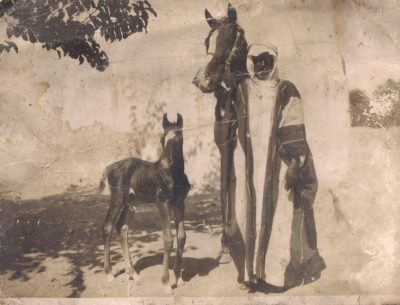Overview of History of Tahawi horses
Yasser Al Tahawi has this excellent overview of the history of the Tahawi horses on his social media page:
• Early 19th century: the great Egyptian conquests in the Middle East (Syria, Arabia, Sudan) … the Tahawies played a major role. Strong connections were developed between the Tahawies and the big tribes of Arabia including Anazah and Shammar.
• Mid 19th century: the Tahawies are granted vast territories on the eastern borders of the Nile Delta … the Bedouin Tahawies are now settling for their first time in history.
• Fall of the 19th century: the Tahawi Sheikhs were busy establishing vast studs and competing in importing the most prestigious strains form the Arabian desert.
• Early 20th century: the Tahawies are the most important breeder in Egypt and its main provider of asil desert-bred horses.
• Fall 19th century to mid 20th century: the Egyptian Royal family and aristocrats, Royal Agricultural Society, Lady Anne Blunt…etc. were all among the Tahawi clients.
• 1940s/50s: around 3,000 heads of the finest Arabians of the time, all with distinguished race records. The peak of the Tahawi glory and their flourishing vast studs.
• 1960s: the Egyptian revolution crackdown on the aristocratic elite and landlords. The Tahawi properties and horses did not escape the confiscation campaigns.
• 1968: the EAO issued the General Stud Book (GSB) that recognized hundreds of Tahawi Arabians.
• 1970s: Establishing the WAHO. EAO abandons the GSB project in favor of the state-owned stud (Al Zahraa)!
• 1970s: Large decline in the number of Asil Tahawi horses and continuous unsuccessful requests to the EAO to register their horses. Exceptions were made to five Tahawi mares; three owned by Hamdan Stables (Fulla, Futna, Bint Barakat) and two of Al-Badeia Stud (Reema, Azima). The three of Hamdan are what is known today around the world as the Tahawi lines. The reset were not allowed into the WAHO registries.
• 1980s: feverish local and international efforts by the Tahawies to recognize and save their declining in rocket speed desert bred Asil Arabians. All requests to EAO and WAHO went astray.
• 1990s and turn of the 21st century: the tragic extinction of the vast majority of the Tahawi lines that once represented a glorious story. The vast majority of the Tahawi studs were either shutdown or turned to part-bred race horses!
• 2009: a number of Tahawies volunteered to rescue the last handful of Asil Tahawi old mares. After extensive research and validation (including mtDNA tests) ten mares and one stallion representing some very rare strains were documented. These few horses were recognized by Al Khamsa and Asil Club in 2011 as asil desert bred. The accepted horses represent seven of the rarest Bedouin strains.
• 2013: The Egyptian Agricultural Organization (EAO) after long negotiations establishes a new parallel registry for the few remaining Tahawi horses under the name “The Asil Bedouin Egyptian Arabian Horses”. The new registry is not falling under the WAHO umbrella.
• 2014 till today: The parallel registry is put on hold by the EAO as a result of strong counter pressures by a number of influential breeders in Egypt! The number of mares declined further. One of the seven stains was lost. However three fillies of three out of six remaining strain were born since 2014.
Efforts are still going to recognize and preserve these horses and revive their rare strains.
Above: Photo of Sheikh Mohammed (bey) Mejalli el-Tahawi with his Saqlwiya Sheafiya mare. Sheikh Mohammed is the breeder of the great race horse Nasr, 1918 (Ghatwan x Saqlawiya Sheafiya) that was acquired by RAS and then exported to Tunisia.

Thank you for posting this excellent review here, Edouard. A reminder of the difficulty and importance of preservation efforts.
The Tahawi horses should be put into the main EAO registry. And, WAHO should get of its dead backside and get them recognized as purebred arabians( so they can ship frozen semen to the west to fix their biomechanically dysfunctional horses.)
If you go through dreamhorse and look at the arab pedigrees you see a whole lot of horses that are essentially in human terms 1st and 2nd cozens. The tragedy of the matter though is that even though many western breeders are aware that they have congenital crooked leg problems and horses that can’t move like a horse they don’t seem to be able to come up with obvious answer to re-infuse true arabian genes from the cradle countrys rather than anglo arab genes from the French racing arabians
best
Bruce Peek
Dear influential breeders in Egypt: If you were smart you would outcross your EAO lines to some of the Tahawi horses. Probably a good choice to breed to Tahawi horses would be horses with lines to Sid Abouhom, and Sameh. Then start training for the Tevis because you are going to able to knock the socks off the horses in the west.
best
Bruce Peek
Well said, Bruce!
Cheers, Bruce!
My first Arab stallion MUAHJID as well as my first mare MUSHKA were mother’s brothers, her name was NEVEEN, born and raised in Hamdan Stables. All my program is based on trying to keep that Tahawy blood present, this is the pedigree of the filly of my last generation:
http://www.allbreedpedigree.com/nueva+ortigosa+ghazala
I appreciate any comments on this. It is so difficult to continue breeding here in Chile with Tahawy blood because there are no other alternatives now.
Sorry no one has replied until now but wow we wish this mare was here in the U.S.
Mr Peek quite insightful-i don’t know about the Tevis but those horses should be very competitive…Interesting history line perspective as well.